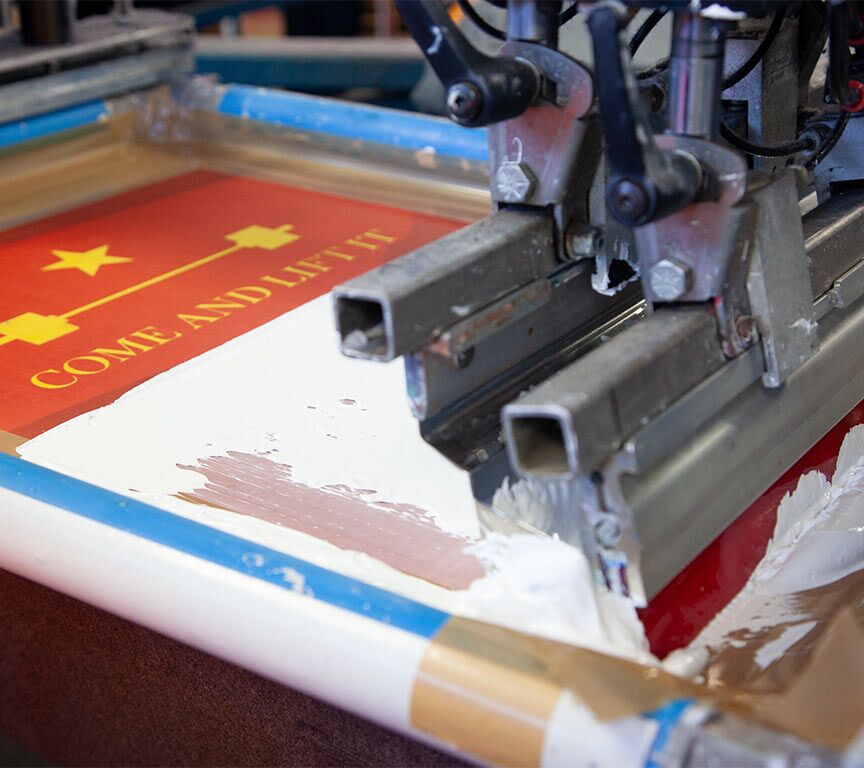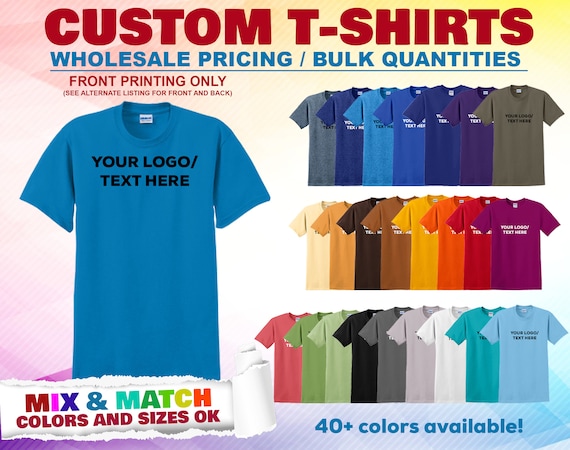Budget-Friendly T-Shirt Printing for Startups
Budget-Friendly T-Shirt Printing for Startups
Blog Article
Screen Printing Uncovered: Everything You Required to Learn About Tee and Garment Printing Methods
Screen printing is a fascinating approach that combines art with method, using limitless possibilities for imagination. Ready to check out the essential elements that make display printing an art form?
The Essentials of Display Printing: How It Functions
When you plunge right into display printing, you'll discover it's both a scientific research and an art. At its core, display printing entails developing a stencil, or screen, that permits ink to pass via just in certain areas.
Following, you'll blend your inks and prepare your printing surface area. Position the display over the textile, after that utilize a squeegee to press ink via the display onto the garment. This procedure calls for precision, as you want clear, lively prints. After printing, you'll heal the ink with heat, guaranteeing it sticks to the textile and lasts via washes. Each action is essential, and understanding them will certainly raise your screen printing skills, transforming straightforward garments right into special, meaningful pieces.
Sorts Of Display Printing Strategies
Once you grasp the basics of screen printing, it's time to discover the numerous methods that can boost your styles. One preferred approach is traditional display printing, where ink is pushed with a stenciled display.
If you're going for great information, consider discharge printing. This technique gets rid of color from the fabric, leaving a soft, classic appearance. An additional alternative is plastisol printing, known for its toughness and dazzling shades, making it a favorite for several brands. Experiment with halftone printing to produce slope results and intricate styles. Each technique has its one-of-a-kind appeal, so do not hesitate to try them bent on find what fits your style best!
Necessary Tools for Screen Printing
To attain sensational lead to screen printing, having the best tools is fundamental. You'll need a strong display printing frame, which holds the mesh that transfers your layout onto the garment. Next off, buy premium squeegees; these are vital for using ink evenly across the display. You'll likewise need a great exposure system to develop your displays, along with a washout cubicle for cleansing them after usage. A trusted warm resource, like a conveyor dryer or warm press, is vital for treating your prints to ensure long life. Do not fail to remember an appropriate office, geared up with tables and storage space for your materials. Lastly, protective equipment, such as gloves and masks, will certainly keep you safe from chemicals and inks. With the right tools, you'll be well on your way to creating professional-quality prints.
Selecting the Right Inks and Materials
When choosing inks and products for display printing, you require to think about the sort of ink that functions best for your project. Assume regarding fabric compatibility to assure your layouts look excellent and last lengthy. Explore environment-friendly ink options to make your printing process a lot more sustainable.
Sorts Of Display Inks
Picking the appropriate display ink is essential for accomplishing vivid, durable prints that satisfy your task's requirements. There are several kinds of screen inks to take a look at. Specialty inks, such as metal or glow-in-the-dark, can include unique results to your designs.

Fabric Compatibility Considerations
Understanding fabric compatibility is essential for attaining top quality display prints, specifically because different materials respond distinctively to different inks. When picking inks, think about the textile type-- cotton, polyester, or blends. For cotton, water-based inks work well, offering softness and breathability. Polyester, on the various other hand, frequently requires plastisol inks for better adhesion and vibrant colors. You might need to make use of a mix of both types if you're printing on blends. Constantly test your inks on sample material to ensure they stick appropriately and maintain shade honesty. Furthermore, remember that textile weight and structure can affect the last end result, so selecting the best ink and material combo is vital for your project's success.
Eco-Friendly Ink Options
Eco-friendly inks are becoming a prominent selection for display printers who want to minimize their ecological effect while preserving high quality. When picking inks, consider water-based inks, which are much less dangerous and less complicated to cleanse up compared to conventional solvents. These inks bond well with textiles, providing lively outcomes without poisonous chemicals. You could also discover eco-solvent inks that use fewer unpredictable natural compounds (VOCs), making them a much safer option for both your health and wellness and the planet.
Additionally, try to find inks made from renewable energies, such as soy or vegetable-based choices. By picking the appropriate inks and products, you'll not just develop spectacular styles however additionally add to a much more lasting printing procedure. Make the button, and your prints will reflect your dedication to the setting!
Preparing Your Design for Display Printing

File Style Requirements
To ensure your design looks sharp and vibrant on material, you'll need to pay attention to file style needs for display printing. Begin with vector data like AI or EPS, as they can be scaled without losing top quality. If you utilize raster pictures, go with high-resolution files, such as TIFF or PNG, ideally at 300 DPI. Prevent using JPEGs, as they can lose quality when resized. Likewise, see to it your layout has a clear history to avoid undesirable white edges on your prints. Finally, her latest blog keep color settings in mind; CMYK is common for display printing, so convert your RGB develops appropriately. By adhering to these standards, you'll set your artwork up for an effective print.
Shade Splitting Up Strategies
Color separation is an important action in preparing your style for screen printing, and grasping it can significantly boost your print top quality. You'll need to break your layout into private colors, as each shade requires a separate screen throughout printing. Beginning by determining all the shades in your layout and produce layers each. You can utilize software application like Adobe Photoshop or Illustrator to isolate and separate shades successfully. Be particular to conserve each layer as a different data, generally in a layout like TIFF or PSD. This precision not just guarantees precise shade depiction however also streamlines the printing process. By taking notice of color separation, you'll achieve dynamic and specialist cause your screen-printed website link garments.
Resolution and Dimension
Attaining the most effective results in display printing starts with assuring your style has the best resolution and size. Ideally, your art work should be at the very least 300 DPI (dots per inch) for sharp, clear prints. If you use reduced resolution, your final item may look unprofessional and pixelated.
When it involves dimension, think about the measurements of your print location. Layout your artwork to match the last print dimension, preferably creating it in the actual measurements you'll be publishing. In this manner, you'll avoid any type of unforeseen scaling issues.
Constantly check your layout in both vector and raster styles. Vector graphics can be scaled without shedding quality, making them optimal for display printing. Preparing correctly will ensure your design looks impressive on every garment!
Step-by-Step Display Printing Process
Display printing is a dynamic procedure that permits you to create dynamic layouts on various surface areas. To get begun, you'll need a screen, solution, and your chosen ink.
After rinsing the unexposed solution, your screen is prepared. Establish it up on your printing surface and align your garment underneath it. Pour ink onto the display and use a squeegee to press the ink with the stencil onto the textile. Raise the screen carefully and allow the print dry. Finally, treat the ink using warm to ensure resilience. That's it! You've effectively display published your design.
Tips for Successful Screen Printing Projects
While you're diving into your screen printing jobs, keep in mind that prep work is vital to success. Start by collecting all your materials-- inks, screens, garments, and mops. A tidy workspace aids prevent undesirable errors, so clean up before you begin.
Next, validate your artwork is high-resolution and correctly sized for your garment. Examine your screen for proper exposure and tidy it completely to continue reading this stay clear of spots. When blending your inks, follow the manufacturer's guidelines to achieve the best uniformity.
Throughout printing, use also pressure with your squeegee for regular outcomes. Don't rush; take your time to confirm each print fulfills your criteria. After printing, allow your garments dry totally before taking care of or packaging them.
Lastly, constantly maintain a sample of your job for future recommendation. In this manner, you can evaluate your development and boost your strategies over time. Delighted printing!

Regularly Asked Questions
How much time Does It Take to Establish a Screen Printing Task?
Establishing up a screen printing task generally takes around 30 mins to an hour. You'll prepare the screens, mix inks, and adjust journalism. The moment varies based upon complexity and experience, so remain organized!
Can I Print on Different Material Enters Using the Same Method?
Yes, you can print on various fabric types utilizing the same technique, however you'll require to adjust your inks and setups. Some fabrics take in ink in different ways, so trying out guarantees the very best outcomes for every material.
What Prevail Mistakes to Prevent in Display Printing?
When display printing, stay clear of usual mistakes like using the wrong ink, overlooking correct exposure times, or skipping pre-press checks. Always evaluate your configuration and maintain tidy displays to guarantee top quality outcomes each time.
Exactly How Can I Correctly Clean and Maintain My Display Printing Devices?
To appropriately clean and preserve your display printing equipment, you ought to on a regular basis wash screens with ideal solvents, check mops for wear, and ensure all tools are saved dust-free and completely dry. Uniformity avoids pricey repair work and improves performance.
Is Screen Printing Eco-friendly Compared to Other Methods?
Display printing can be a lot more eco-friendly than various other approaches, specifically if you use eco-conscious products and water-based inks. By selecting lasting supplies and practices, you decrease waste and decrease your impact on the earth.
Screen Printing Uncovered: Whatever You Need to Know Concerning Tee and Garment Printing Strategies
At its core, screen printing includes developing a pattern, or display, that permits ink to pass with just in specific areas. Placement the display over the textile, after that use a squeegee to press ink through the screen onto the garment. One prominent technique is typical display printing, where ink is pressed with a stenciled display.When choosing inks and materials for display printing, you require to take into account the type of ink that works finest for your job.
Report this page